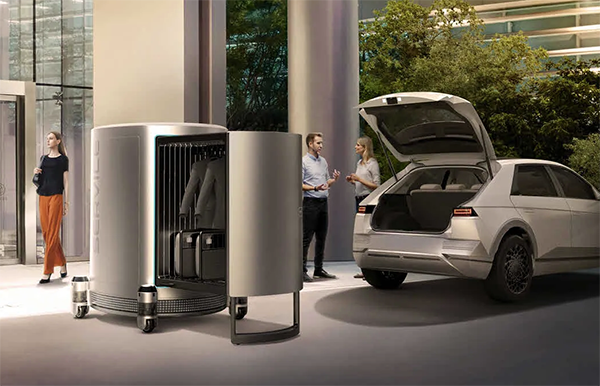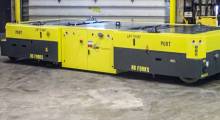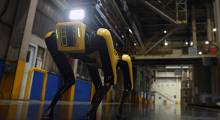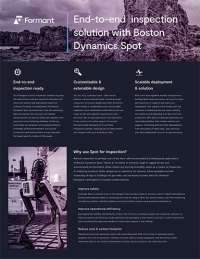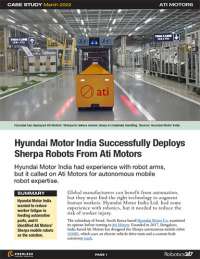At the international Consumer Electronics Show in Las Vegas this week, Hyundai Motor Co. showed humanoid robots and modular mobility platforms as it discussed its “metamobility” and “Mobility of Things” concepts.
In its exhibit, which had the theme “Expanding Human Reach,” Hyundai offered three 20-minute-long dynamic movement demonstrations of four robots, including the Spot quadruped and three new systems.
Like other automakers, Hyundai said a combination of artificial intelligence, virtual reality (VR), robotics, autonomous vehicles, and urban air mobility (UAM) will lead to the ability to move goods and people on demand, blurring the distinctions between transport modes.
Hyundai explains Metamobility concept
With Metamobity, Hyundai said smart devices will connect with the real world, as well as with the virtual world known as the “metaverse,” a term coined by cyberpunk author Neal Stephenson and popularized by Facebook as it renamed itself as Meta.
“The idea behind Metamobility is that space, time, and distance will all become irrelevant,” said Chang Song, president and head of the Transportation-as-a-Service (TaaS) division of Hyundai Motor Group. “By connecting robots to the metaverse, we will be able to move freely between both the real world and virtual reality.”
“Going one step further from the immersive ‘be there’ proxy experience that the metaverse provides, robots will become an extension of our own physical senses, allowing us to reshape and enrich our daily lives with Metamobility,” he said.
“Unlike the current incarnation of VR, where user experiences are not reflected in the real world due to technological limitations, future metaverse users will be able to affect changes in the real world through robotics and digital twin technology,” Hyundai said. “For example, when a user accesses a digital twin of their home in the metaverse while away from their physical home, they will be able to feed and hug a pet in Korea through the use of an avatar robot.”
In addition, users could use the metaverse to directly control proxy robots in remote work sites, such as a smart factory with a digitial twin, and manipulate objects for physical tasks.
Hyundai shows modular mobility
“We are directing all our robotics engineering and creative efforts toward building the unlimited Mobility of Things ecosystem,” said Dong Jin Hyun, vice president and head of the Robotics Lab at Hyundai Motor Group. “The goal is for robotics to enable all kinds of personal mobility, connected to communicate, move, and perform tasks autonomously.”
As part of its Mobility of Things (MoT) concept, which builds on the idea of the Internet of Things (IoT), Hyundai said its Plug & Drive (PnD) “enables the mobility of traditionally inanimate things, from small objects to large community spaces.”
Hyundai described the modular platform as “an all-in-one mobility solution that combines intelligent steering, braking, in-wheel electric drive, and suspension hardware. The single-wheel unit uses a steering actuator for infinite wheel rotation, meaning it can turn 360 degrees, which enables holonomic movement, like a figure skater.”
The company added that the PnD will include cameras and lidar to move autonomously for any application, said Hyun. The configurable technology could provide “freedom of movement for people with disabilities, automated logistics, reconfigurable interior space, and public transportation, with individual compartments for social distancing and last-mile mobility,” Hyundai said.
Hyundai cited examples including Personal Mobility or private autonomous vehicles, Logistics Mobility or delivery robots, and Service Mobility for moving items such as luggage. An “L7” platform using four large PnD modules could be useful for for transportation and logistics in restricted spaces, the company said.
MobED designed for robust micromobility
Hyundai Motor also exhibited the MobED (Mobile Eccentric Droid). The small mobility platform uses four Drive & Lift (DnL) modules, which can extend the operation of robots to both indoor and outdoor locations, according to the company.
The DnL module includes an “eccentric wheel mechanism that combines the drive, steering and braking systems into one structure,” said Hyundai. With DnL mounted on each wheel, MobED can lift the platform up and down, so the body can stay level as it traverses uneven terrain or low barriers such as steps or speed bumps.
Hyundai added that MobED could be combined with a screen as a mobile guide or improve micromobility for the elderly and people with disabilities.
“We envision future mobility solutions made possible by advanced robotics — even expanding our mobility solutions to Metamobility,” said Euisun Chung, executive chair of Hyundai Motor Group. “This vision will enable unlimited freedom of movement and progress for humanity.”
Last year, Hyundai's New Horizons Studio showed Elevate, an “Ultimate Mobility Vehicle” created with generative design that combined wheels and legs. The company has also partnered with Motional Inc. on the IONIQ 5 robotaxi.
Boston Dynamics, Hyundai envision collaborative future
Boston Dynamics, which Hyundai acquired last year, demonstrated its Spot quadruped robot and Atlas humanoid robot at CES 2022. Spot can collect data for inspection, construction, and security, and Atlas has demonstrated human-level agility. Hyundai showed Spot working with Logistics Mobility for last-mile delivery.
Waltham, Mass.-based Boston Dynamics is also developing the Stretch robotic arm for palletizing and depalletizing.
Hyundai and Boston Dynamics are already taking mobility beyond human physical limitations, said Marc Raibert, founder and chairman of Boston Dynamics. Together, they envision a future in which people and robots work together, improving safety, productivity, and the quality of life, he said.
Raibert noted that Hyundai’s Vest Exoskeleton (VEX) and Chairless Exoskeleton (CEX) wearable devices, as well as Spot, are supporting industrial work and hold promise for applications such as search-and-rescue missions.
“We see a future where robots become more than just task-oriented tools, more than just machines,” Raibert said. “We believe in a future where robots become useful, trusted companions in our everyday lives.”
About the Author
Follow Robotics 24/7 on Linkedin
Article topics
Email Sign Up

